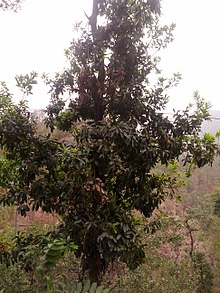
Myrica esculenta

Myrica esculenta is a tree or large shrub native to the hills of northern India, southern Bhutan and Nepal. Its common names include box myrtle, bayberry, and kaphal. Its berries are edible and are consumed locally. Myrica esculenta is found in hilly regions of northern India and Nepal especially in the regions of Garhwal and Kumaon of Uttarakhand, southern Bhutan and western Nepal especially at elevations of 900–1,800 m (3,000–6,000 ft). It is also found at elevations below 1,500 m (4,900 ft) in the midhills of Nepal. It is also found in Himachal Pradesh, India where it is known as Kafal. Myrica esculenta has a tree of medium height, about 6 to 8 m (20 to 26 ft). Bark is soft and brittle. Leaves are conjoint, 30–60 cm (1–2 ft) feet long that has leaflets in pairs of 6 to 9 and has a width of 19 mm (0.75 in). Flowers are of white color and are found in bunches. Fruit is a globose, succulent drupe, with a hard endocarp; diameter 1.1–1.3 cm (0.43–0.51 in); average mass 670 mg (10.3 gr). Seeds are triangular in shape and are astringent in taste. According to Ayurveda, it has two varieties based on the color of flower: Shweta (white) and Rakta (red). The bark is yellow and contains the chemical substances myricetin, myricitrin and glycosides. Leaves of the plant also contain flavone-4'-hydroxy-3',5,5'-trimethoxy-7-O-β-I-D-glucopyranosy)(1→4)-α-L-rhamnopyranoside; flavone-3',4'-dihydroxy-6-methoxy-7-O-α-L-rhamnopyranoside; β-sitosterol; β-sitosterol-β-D-glucopyranoside and quercetin.
